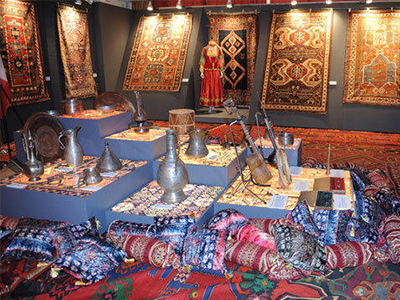Culture of Azerbaijan
As one of the oldest nations of the world, the people ofAzerbaijanare proud of their history, material and cultural monuments, rich literature, art and music culture. Beautiful nature, climate (there are 9 climate zones in Azerbaijan), richness of natural resources had a great impact on the artistic thinking and creativity of the people of Azerbaijan. Despite the fact that each of the different types of art havehad long and complicated way of development, together, they provide a broad opportunity to create a complete picture of Azerbaijani art and culture.As the nature of our country, the art of Azerbaijan is also colorful, full and rich.
 Folk art that closely related to the household and daily life of Azerbaijani people takes important place in the creativity of Azerbaijan. Now it is possible to see many beautiful examples of folk art of Azerbaijan in the richest museums of the world. While observing the richest museums such as, Victoria and Albert in London, the Louvre in Paris, Metropolitanin Washington, and other museums of Vienna, Rome, Berlin, Istanbul, Tehran, Cairo, you can see the artwork created by the skillful hands of the masters from Tabriz, Nakhchivan, Ganja, Gazakh, Guba, Baku, Shaki, Shamakhi and Karabakh.
Folk art that closely related to the household and daily life of Azerbaijani people takes important place in the creativity of Azerbaijan. Now it is possible to see many beautiful examples of folk art of Azerbaijan in the richest museums of the world. While observing the richest museums such as, Victoria and Albert in London, the Louvre in Paris, Metropolitanin Washington, and other museums of Vienna, Rome, Berlin, Istanbul, Tehran, Cairo, you can see the artwork created by the skillful hands of the masters from Tabriz, Nakhchivan, Ganja, Gazakh, Guba, Baku, Shaki, Shamakhi and Karabakh.
The handcraft created by our people and used in their household and daily life has great and rich history.The works of art made of metal obtained from Nakhchivan, Mingachevir, Gadabay, Gazakh, Ganja etc. are about 5000 years old. The dishes, guns and jewelries found in those territories are both historical facts and valuable resources that give information about the mastery of the artist who made it. Material and cultural samples found during excavations in the territory of Azerbaijan show that our ancestors made bronze-shaped dishes, daggers, axes, belts, jewelries etc. in the 2nd millennium BC and used it in their household and everyday life. Thus, it informs us about the antiquity of arts such as coppering and jewelry art.
The history, ethnographic and artistic features of folk art reflected in the clothes. This feature manifests itself both in certain forms of clothing and its decorations, as well as in artistic embroidery, weaving and knitting. Different drawings on house equipments and jewelries made of copper, bronze and gold prove that fine art was available in Azerbaijan in ancient times.
A picture of a sack decorated with floral paintings on a horse figure made of clay (II millennium BC) and found in Maku city of South Azerbaijan, and a description of a lion on a surface of a gold glass found in Hasanli hill near the Urmia Lake prove that carpet weaving in Azerbaijan has also very ancient history.
During archeological excavations remains of carpets and rugs belonging to I-III centuries were found from catacomb graves in Mingechevir. According to the archeological materials and written sources carpet weaving in Azerbaijan has been practiced since the Bronze Age (late 2nd millennium BC - early 1st millennium BC). Herodotus, Claudius Aelianus, Xenophon and other ancient world historians gave information about the development of carpet weaving in Azerbaijan. The carpets woven in carpet weaving schools of Azerbaijan (Guba, Baku, Shirvan, Ganja, Gazakh, Karabakh, Tabriz) at different times still fascinate people with their beauties. Most of them are kept in famous museums of the world.
Among the examples of fine art there are Gobustan rock paintings of VIII-V centuries BC, drawings (3rd millennium BC) in Ayichingili and Parichingil mountains of Kalbajar region around the Zalkha Lake belonging to the Bronze Age, rock paintings in Gamigaya mountains, the north of Ordubad city. Various plots, scenes, human and animal images related to hunting, cattle breeding, agriculture and other spheres of life are dynamically engraved here. Gobustan rock paintings - pictograms cover a long historical period from the primitive community structure to the stage of feudalism.
Azerbaijan has been rich in works of fine art since ancient times, as well as architectural works, a branch of folk art. Maiden Tower and Shirvanshahs Palace complex in Baku, tombs of Momina Khatin and Yusif ibn Kuseyir created by architect Ajami in Nakhchivan, Panahali khan's palace in Shusha, Natava's house, paintings on the wall of Sheki khans' palace, etc. are rare pearls of architectural art. Painting of people dancing "Yalli" (dance) is very interesting among the rock paintings of Gobustan. These images show the interest of the Azerbaijani people in music since ancient times.
